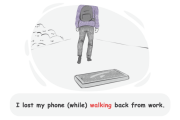Present Participles
In this lesson we learn about present participles, which are essential verb forms ending in -ing that function as adjectives or form part of continuous verb tenses. Clear explanations and practice exercises to help you learn.

What Is a Present Participle?
The present participle is a verb form ending in "-ing" that is used in various grammatical structures. While it originates from verbs, it often functions as an adjective, part of a verb phrase or part of a present participle clause in a sentence.
Present Participle: From
Present participles are formed by adding '-ing' to the base form of the verb.
Take a look at some examples:
Sleep → Sleeping
Wait → Waiting
Now pay attention to their use in sentences:
They were sleeping when I got there.
He was waiting for more than an hour.
Spelling Rules
Sometimes, to form present participles, simply adding '-ing' is not enough and the verb will require other changes. Here we will discuss the rules:
If the verb ends in consonant + stressed vowel + consonant, double the final letter.
Stop → Stopping
Run → Running
If the verb ends in consonant + unstressed vowel + consonant, (the base verb is not stressed) do not double the final letter.
Open → Opening
If the verb ends in '-ie', replace the 'ie' with 'y'.
Lie → Lying
Die → Dying
If the verb ends in vowel + consonant + '-e', omit the '-e.'
Come → Coming
Mistake → Mistaking
Present Participle: Uses


Present participles can serve various functions, including the following:
1. Present Participles in Continuous Tenses
In the table below you can see all the continuous tenses that are formed using present participles. These tenses are used to describe ongoing actions and events. These actions and events may be in the present, past, or future.
Tenses | Examples |
|---|---|
You are studying English grammar. | |
I was working when it all happened. | |
I'm tired because I've been running. | |
Kaz was exhausted. He had been running. | |
I'll be waiting for you. | |
I will have been waiting for two hours. |
3. Present Participles in Participle Clauses
Participle clauses are dependent clauses that use the present participle form of a verb to show that two actions happened simultaneously, or that one action is the result or reason of another. Take a look at some examples:
I lost my phone while walking back from work.
He walked out whistling to himself.
Present participle clauses can act as nouns, adjectives, and adverbs. As nouns, they can be subjects, objects of verbs or prepositions, as well as complements. Here are some examples:
The man carrying the heavy box struggled to keep his balance.
present participle clause used as an adjective
Hoping to win the game, the team practiced every day.
present participle clause used as an adverb
Traveling to new places is my favorite hobby.
present participle clause used as subject
She enjoys painting landscapes during her free time.
present participle clause used as object of verb
His main hobby is collecting rare stamps.
present participle clause used as subject complement
2. Present Participles as Adjectives
Present participles can serve as adjectives in sentences. As adjectives, they can describe nouns. Take a look at some examples:
To interest → Interesting
To tire → Tiring
Pay attention to their use in sentences:
I was trying to make things interesting.
He tries his best but his tiring job won't give him a break.
4. Present Participles as Prepositions
The present participle form of some verbs can be used as prepositions; for example, assuming, regarding, considering, excluding, including, pending, barring, and following. Look at the examples below to see how they work in sentences.
Considering his qualifications, he is the best candidate for the job.
Following the meeting, we went out for lunch.
Review
The present participle is actually a bare infinitive followed by 'ing.' This form of the verb can be used for:
Making continuous tenses
Making -ing adjectives
Making participle clauses
Making participle phrases
Quiz:
What is the present participle form of the verb "prefer"?
preferring
prefereing
prefering
preferying
Fill in the blanks with the correct present participle form of the verbs in parentheses.
She is
(run) in the park every morning.
They were
(wait) for the bus when it started raining.
I am
(lie) on the beach enjoying the sunshine.
He was
(stop) to help a woman who had dropped her bags.
The children are
(play) outside in the garden.
Which of the following sentences uses the present participle as a preposition?
Running through the park is fun.
He was tired after running a marathon.
We have some news regarding your request.
She was regarding the painting with interest.
Sort the words to form a correct sentence.
Fill the table with the role of the present participle in the sentence.
| Sentence | Role of present participle |
|---|---|
She was laughing when I arrived. | |
Traveling the world has always been his dream. | |
Following the instructions, he completed the task. | |
The story was exciting. | |
He was singing loudly in the shower. | |
Following the storm, the sky cleared up. | |
The movie was boring, so I left early. |
Comments
(0)